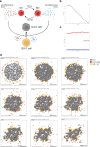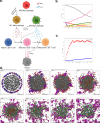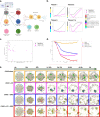This is a preprint.
Digitize your Biology! Modeling multicellular systems through interpretable cell behavior
- PMID: 37745323
- PMCID: PMC10516032
- DOI: 10.1101/2023.09.17.557982
Digitize your Biology! Modeling multicellular systems through interpretable cell behavior
Update in
-
Human interpretable grammar encodes multicellular systems biology models to democratize virtual cell laboratories.Cell. 2025 Aug 21;188(17):4711-4733.e37. doi: 10.1016/j.cell.2025.06.048. Epub 2025 Jul 26. Cell. 2025. PMID: 40713951
Abstract
Cells are fundamental units of life, constantly interacting and evolving as dynamical systems. While recent spatial multi-omics can quantitate individual cells' characteristics and regulatory programs, forecasting their evolution ultimately requires mathematical modeling. We develop a conceptual framework-a cell behavior hypothesis grammar-that uses natural language statements (cell rules) to create mathematical models. This allows us to systematically integrate biological knowledge and multi-omics data to make them computable. We can then perform virtual "thought experiments" that challenge and extend our understanding of multicellular systems, and ultimately generate new testable hypotheses. In this paper, we motivate and describe the grammar, provide a reference implementation, and demonstrate its potential through a series of examples in tumor biology and immunotherapy. Altogether, this approach provides a bridge between biological, clinical, and systems biology researchers for mathematical modeling of biological systems at scale, allowing the community to extrapolate from single-cell characterization to emergent multicellular behavior.
Conflict of interest statement
Declaration of interests JZ receives other support from Roche/Genentech. LZ receives grant support from Bristol-Myers Squibb, Merck, Astrazeneca, iTeos, Amgen, NovaRock, Inxmed, and Halozyme. LZ is a paid consultant/Advisory Board Member at Biosion, Alphamab, NovaRock, Ambrx, Akrevia/Xilio, QED, Tempus, Pfizer, Novagenesis, Snow Lake Capitals, Amberstone, Tavotek Lab, ClinicalTrial Options, LLC, and Mingruizhiyao. LZ holds shares at Amberstone, Alphamab, Cellaration, and Mingruizhiyao. EJ reports other support from Abmeta, Adventris, personal fees from Achilles, DragonFly, Neuvogen, Parker Institute, CPRIT, Surge, Mestag, Medical Home Group, and HDTbio, grants from Lustgarten, and other grant support from Genentech, BMS, NeoTX, and Break Through Cancer outside the submitted work. Dr. Jaffee is the Dana and Albert “Cubby” Broccoli Professor of Oncology. EJF is on the Scientific Advisory of Resistance Bio/Viosera Therapeutics, a paid consultant for Merck and Mestag, and receives research funds from Abbvie Inc and Roche/Genetech.
Figures







References
-
- Rozenblatt-Rosen O., Regev A., Oberdoerffer P., Nawy T., Hupalowska A., Rood J.E., Ashenberg O., Cerami E., Coffey R.J., Demir E., et al. (2020). The Human Tumor Atlas Network: Charting Tumor Transitions across Space and Time at Single-Cell Resolution. Cell 181, 236–249. 10.1016/j.cell.2020.03.053. - DOI - PMC - PubMed
-
- Stein-O’Brien G.L., Le D.T., Jaffee E.M., Fertig E.J., and Zaidi N. (2023). Converging on a Cure: The Roads to Predictive Immunotherapy. Cancer Discov 13, 1053–1057. 10.1158/2159-8290.CD-23-0277. - DOI - PMC - PubMed
Publication types
Grants and funding
- R00 NS122085/NS/NINDS NIH HHS/United States
- 75N91019D00024/CA/NCI NIH HHS/United States
- P50 CA221707/CA/NCI NIH HHS/United States
- K08 CA248624/CA/NCI NIH HHS/United States
- P01 CA247886/CA/NCI NIH HHS/United States
- U54 CA268083/CA/NCI NIH HHS/United States
- T32 GM148383/GM/NIGMS NIH HHS/United States
- T32 CA153952/CA/NCI NIH HHS/United States
- U01 CA294548/CA/NCI NIH HHS/United States
- R01 CA169702/CA/NCI NIH HHS/United States
- U01 CA232137/CA/NCI NIH HHS/United States
- P50 CA062924/CA/NCI NIH HHS/United States
- P30 CA006973/CA/NCI NIH HHS/United States
- U24 CA284156/CA/NCI NIH HHS/United States
- U54 CA274371/CA/NCI NIH HHS/United States
- U01 CA253403/CA/NCI NIH HHS/United States
- K99 NS122085/NS/NINDS NIH HHS/United States
- U01 CA212007/CA/NCI NIH HHS/United States
- R01 CA197296/CA/NCI NIH HHS/United States
LinkOut - more resources
Full Text Sources
